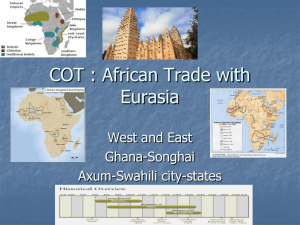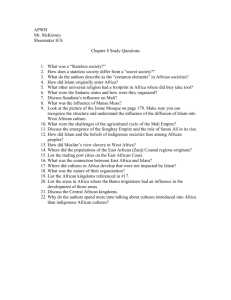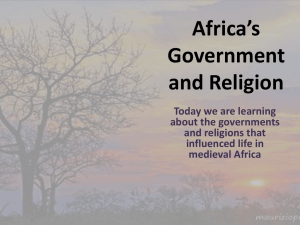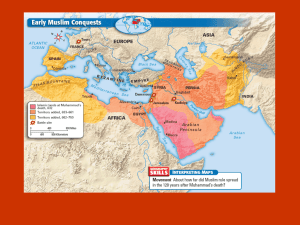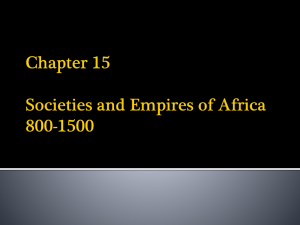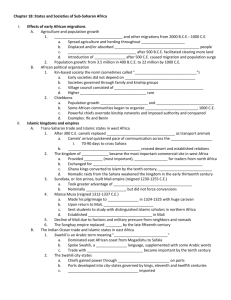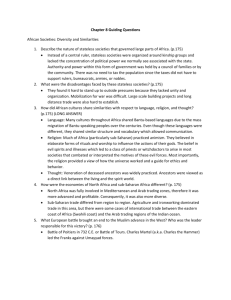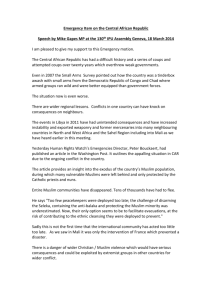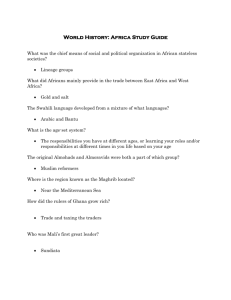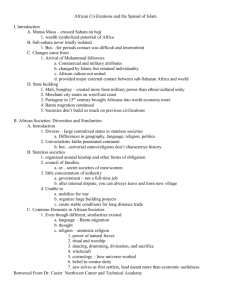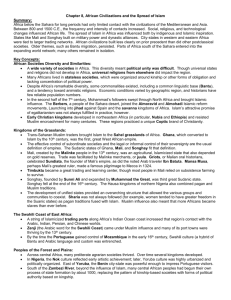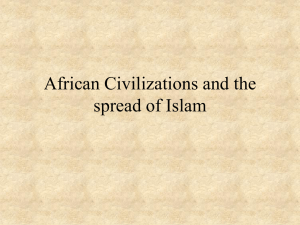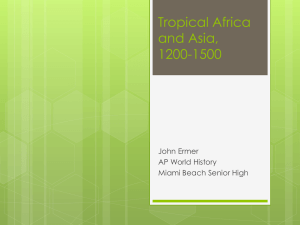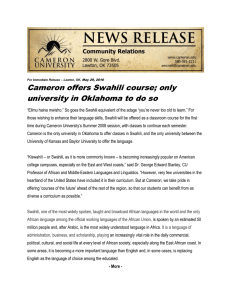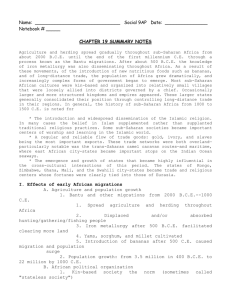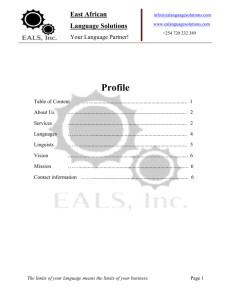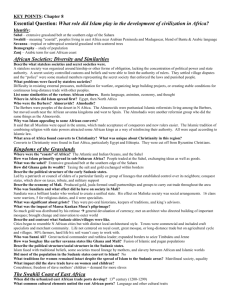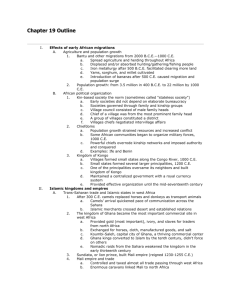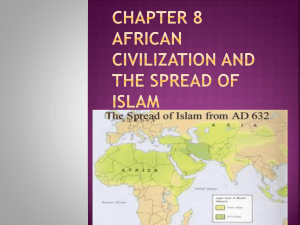Africa During the Post classical Period
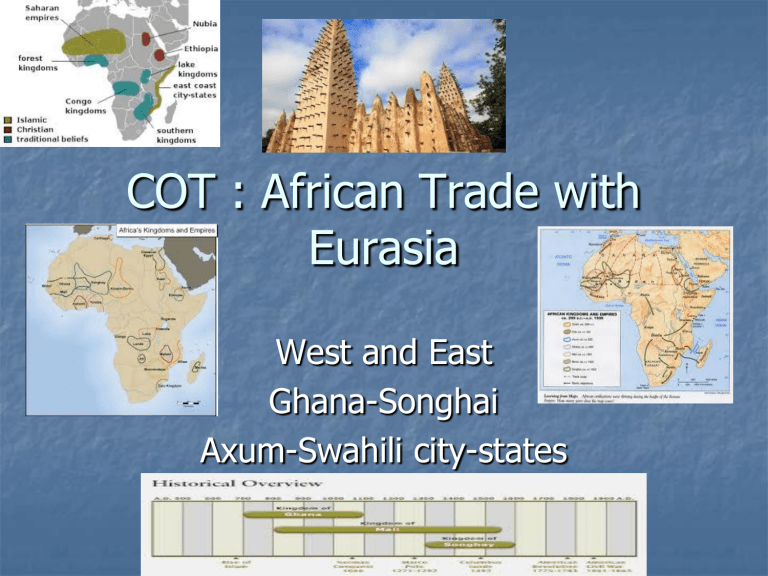
COT : African Trade with
Eurasia
West and East
Ghana-Songhai
Axum-Swahili city-states
Africa During the Post classical
Period
From stateless
Societies to
Empires the
Desire for
Sudanic Gold
Permeated the period, the Arab
Slave trade will
Also begin this
Period and
Continue through
The 20 th century
East Coast begins
As Christian
Kingdom of
Axum est
Mediterranean
And Red Sea
Trade with Rome
Later Byzantine
Only to move
Inward once
Muslim invaders
Come in and
Integrate into
Coastal (Swahili)
City-states
African Kingdom Similarities and
Differences
Common Elements in African
Societies
Bantu migration(ends 1000 C.E)
Animism lineage important in relation with god (matrilineal)
The Christian
Kingdoms: Nubia and
Ethiopia
Copts
Women elevated in society
(bridewealth)
Egyptian Christians
The Arrival of Islam in North
Africa
Arrival of Islam (Spain, by 711)
Berber Almoravids
spread to Nubia (Kush)
Ethiopia-interior migration after Muslim expansion
Almohads succeed Berbers, 12th century
Kingdom of mali est. 13th h ce providing 2/3 of World’s gold
Empires of Africa
Kingdoms of the
Grasslands
Caravans
Sahel - transfer point
Sudanic States
Rulers sacred
Islam
Mansa Kankan Musa
pilgrimage
Ishal al-Sahili (Sp.
Architect)
beaten clay architecture
Established city of
Timbuktu (Islamic
Scholarship flourishes)
Empires of the Western Sudan
The Empire of Mali
Malinke peoples from
Ghana
Agriculture, gold trade
Sundiata (d.1260)
the “Lion Prince” mansa (ruler) expanded state
City Dwellers and
Villagers
Jenne, Timbuktu
thrive with expansion
African Kingdoms
The Songhay Kingdom
(Capital: Gao)
Middle Niger valley
Independent by 700
Muslim by 1010
Sunni Ali (1464-1492)
Hausa states, northern
Nigeria
Muslim center
Some merchants
Religious diffusion?
Majority farmers
Political and Social Life in the
Sudanic States
Fusion of traditions
Swahili Coast
The Swahili Coast of East Africa
Trading ports
Muslim influence
Cultural diffusion and synthesis
The Coastal Trading Ports
(*Mogadishu*, Mombasa, Malindi,
Kilwa, Pate, Zanzibar)
Don’t need to know, just be familiar
Madagascar
SEA imports
The Swahili Coast
Blended culture (Bantu-Arabic-India)
Swahili Coast (cont’d)
The Mixture of Cultures on the
Swahili Coast
Islam unifies
Other Characteristics
Egalitarian/homogenous to cosmopolitan/diverse
Key Exports & Imports (interior African goods for exterior Eurasian good)
Two distinct “trading seasons”
Connection to China?
When did this exchange with China end?
COT Africa Trade 600-1450
Changes
Mali and Songhai
Expanded trade past Mediterranean world
Swahili city-states
Role of Indian Ocean trade
Role of Islam
Mansa Musa’s Hajj
Timbuktu and Jene Jene
Gold and Salt trade increased with Europe’s insatiable demand
Camel caravanaseri’s increase due to the increased global demand for African goods (Gold, animal skins, ivory,)
Soldiers cleared land for planting rice, yams, beans and to raise cattle, sheep and goats
Mali became productive farming region
Rainforest Kingdoms like Benin and Kongo provide woven fabrics and wood, ivory and metal art for trade)
Africans who were the link (middlemen) between foreign traders and iInland Africans brought: gold, copper, & ivory Arab traders brought: porcelain, spices & fabrics
Met in coastal city-states ( Mombasa, Sofala, Kilwa)
Use of the Arab Dhow to utilize seasonal monsoon winds
Continuities
Camel Caravans
Trans-Saharan tade
Use of Nile and red sea for trade (coptic Christianity still in East Africa modern Ethiopia)
Animism still predominant
Women still important economically ( cattle raisers, matrilineal, bridewealth)
Stateless societies persist which engage in trade
Gold and Sal trade continue
Regional trade still exists amongst African stateless societies (although now increasingly interconnected with global trade)
Geography still serves to hinder many merchants’
Use of iron metallurgy still important for agriculture and safe trade
Bantu still a commonly spoken family of languages for merchants.
Dumb barter still utilized (although replaced in many areas by Muslim regulations on trade)
From 600-1450 African trade intensified across the Sahara and Indian Ocean aided and abetted by the growth of the Muslim territories, it enhanced trade regulations through the enforcement of Sharia, Koran and hadith, however, the commodities of gold, salt, iron and ivory remain staples for the economies of
African stateless societies.
